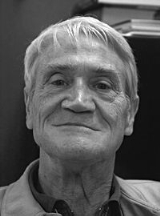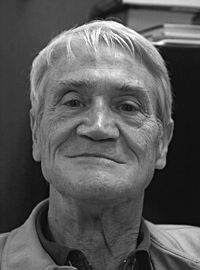
Wesley A. Clark
Encyclopedia

Computer scientist
A computer scientist is a scientist who has acquired knowledge of computer science, the study of the theoretical foundations of information and computation and their application in computer systems....
and one of the main participants, along with Charles Molnar
Charles Molnar
Charles Edwin Molnar was a co-developer of one of the first minicomputers, the LINC , while a graduate student at the Massachusetts Institute of Technology in 1962. His collaborator was Wesley A. Clark....
, in the creation of the LINC
LINC
The LINC was a 12-bit, 2048-word computer. The LINC can be considered the first minicomputer and a forerunner to the personal computer....
laboratory computer, which was the first mini-computer and shares with a number of other computers (such as the PDP-1
PDP-1
The PDP-1 was the first computer in Digital Equipment Corporation's PDP series and was first produced in 1960. It is famous for being the computer most important in the creation of hacker culture at MIT, BBN and elsewhere...
) the claim to be the inspiration for the personal computer
Personal computer
A personal computer is any general-purpose computer whose size, capabilities, and original sales price make it useful for individuals, and which is intended to be operated directly by an end-user with no intervening computer operator...
.
Clark was born in New Haven, Connecticut
New Haven, Connecticut
New Haven is the second-largest city in Connecticut and the sixth-largest in New England. According to the 2010 Census, New Haven's population increased by 5.0% between 2000 and 2010, a rate higher than that of the State of Connecticut, and higher than that of the state's five largest cities, and...
and grew up in northern California. He graduated from the University of California, Berkeley
University of California, Berkeley
The University of California, Berkeley , is a teaching and research university established in 1868 and located in Berkeley, California, USA...
in 1947, and received an electrical engineering
Electrical engineering
Electrical engineering is a field of engineering that generally deals with the study and application of electricity, electronics and electromagnetism. The field first became an identifiable occupation in the late nineteenth century after commercialization of the electric telegraph and electrical...
degree from MIT in 1955. Clark worked for Washington University from 1964–72, and as a consultant thereafter. He founded Clark, Rockoff, and Associates in Brooklyn, New York, with his wife, Maxine Rockoff. His oldest son, Douglas, is a professor of computer science at Princeton University
Princeton University
Princeton University is a private research university located in Princeton, New Jersey, United States. The school is one of the eight universities of the Ivy League, and is one of the nine Colonial Colleges founded before the American Revolution....
.
The New York Times series on the history of the personal computer had this to say in an article on August 19, 2001 "How the Computer Became Personal":
In the pantheon of personal computing, the LINC, in a sense, came first—more than a decade before Ed RobertsEd Roberts (computers)Henry Edward "Ed" Roberts was an American engineer, entrepreneur and medical doctor who designed the first commercially successful personal computer in 1975. He is most often known as "the father of the personal computer"...
made PC's affordable for ordinary people. Work started on the Linc, the brainchild of the M.I.T. physicist Wesley A. Clark, in May 1961, and the machine was used for the first time at the National Institute of Mental HealthNational Institute of Mental HealthThe National Institute of Mental Health is one of 27 institutes and centers that make up the National Institutes of Health...
in Bethesda, MD, the next year to analyze a cat's neural responses.
Each Linc had a tiny screen and keyboard and comprised four metal modules, which together were about as big as two television sets, set side by side and tilted back slightly. The machine, a 12-bit computer, included a one-half megahertz processor. Lincs sold for about $43,000—a bargain at the time—and were ultimately made commercially by Digital Equipment, the first minicomputer company. Fifty Lincs of the original design were built.
Clark had a small but key role in the planning for the ARPANET
ARPANET
The Advanced Research Projects Agency Network , was the world's first operational packet switching network and the core network of a set that came to compose the global Internet...
(the predecessor to the Internet
Internet
The Internet is a global system of interconnected computer networks that use the standard Internet protocol suite to serve billions of users worldwide...
). In 1967, he suggested to Larry Roberts
Lawrence Roberts (scientist)
Lawrence G. Roberts received the Draper Prize in 2001 and the Principe de Asturias Award in 2002 "for the development of the Internet" along with Leonard Kleinrock, Robert Kahn, and Vinton Cerf....
the idea of using separate small computers (later named Interface Message Processor
Interface Message Processor
The Interface Message Processor was the packet-switching node used to interconnect participant networks to the ARPANET from the late 1960s to 1989. It was the first generation of gateways, which are known today as routers. An IMP was a ruggedized Honeywell DDP-516 minicomputer with...
s) as a way of standardizing the network interface and reducing load on the local computers.
In 1981 Clark received the Eckert-Mauchly Award
Eckert-Mauchly Award
The Eckert–Mauchly Award recognizes contributions to digital systems and computer architecture. First awarded in 1979, it was named for John Presper Eckert and John William Mauchly, who between 1943 and 1946 collaborated on the design and construction of the first large scale electronic computing...
for his work on computer architecture. He was elected to the National Academy of Engineering
National Academy of Engineering
The National Academy of Engineering is a government-created non-profit institution in the United States, that was founded in 1964 under the same congressional act that led to the founding of the National Academy of Sciences...
in 1999.
External links
- Oral history interview with Wesley Clark. Charles Babbage InstituteCharles Babbage InstituteThe Charles Babbage Institute is a research center at the University of Minnesota specializing in the history of information technology, particularly the history since 1935 of digital computing, programming/software, and computer networking....
, University of Minnesota. Clark describes his research at Lincoln LaboratoryLincoln LaboratoryMIT Lincoln Laboratory, located in Lexington, Massachusetts, is a United States Department of Defense research and development center chartered to apply advanced technology to problems of national security. Research and development activities focus on long-term technology development as well as...
and interaction with the Information Processing Techniques Office (IPTO) of the Advanced Research Projects Agency (ARPA). Topics include various custom computers built at MIT, including the LINCLINCThe LINC was a 12-bit, 2048-word computer. The LINC can be considered the first minicomputer and a forerunner to the personal computer....
computer; timesharing and network research; artificial intelligence research; ARPA contracting; interaction with IPTO directors; the work of Larry RobertsLawrence Roberts (scientist)Lawrence G. Roberts received the Draper Prize in 2001 and the Principe de Asturias Award in 2002 "for the development of the Internet" along with Leonard Kleinrock, Robert Kahn, and Vinton Cerf....
at IPTO. - Functional Description of the L1 Computer, March 1960 at bitsavers.org
- The Logical Structure of Digital Computers, October 1955 at bitsavers.org
- Multi-Sequence Program Concept, November, 1954 at bitsavers.org

